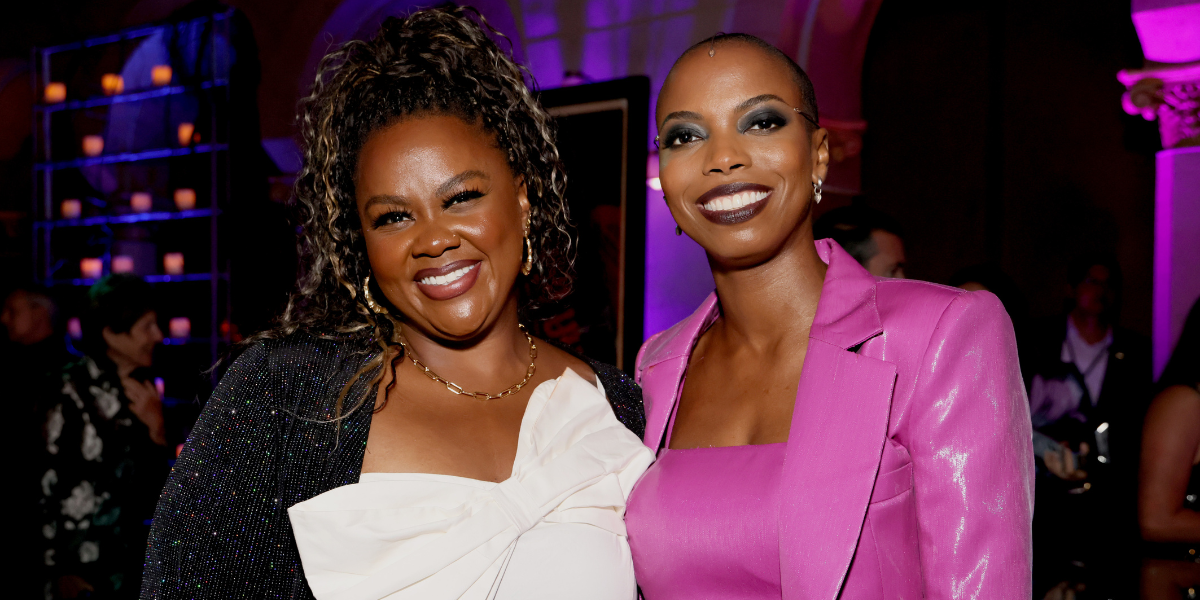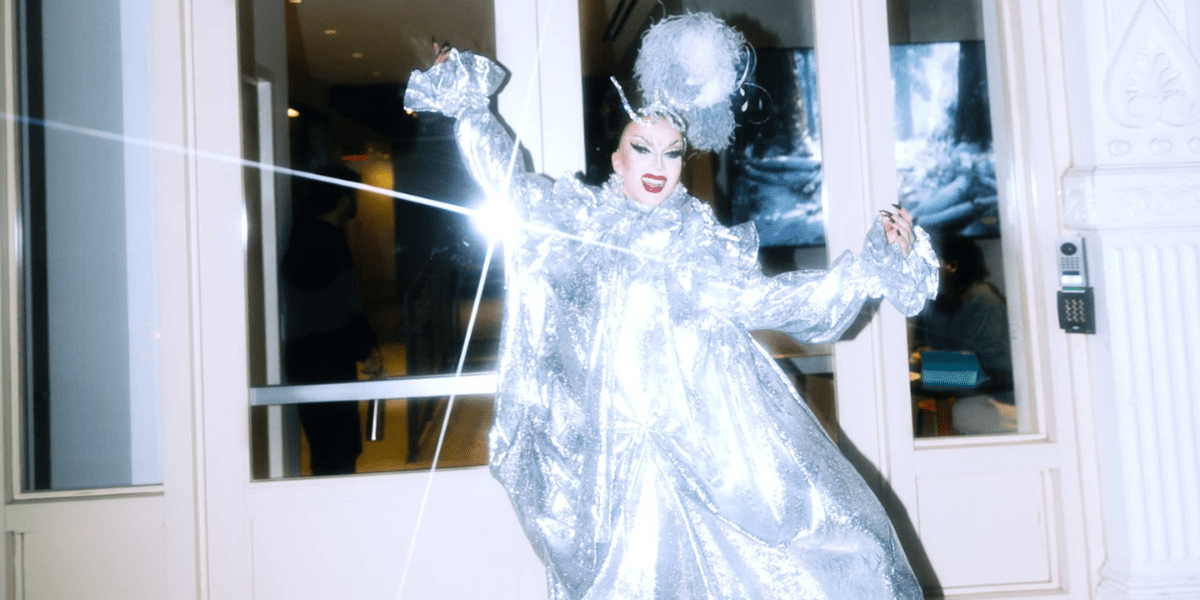In Autostraddle’s The State of the Lesbian Bar, we’re taking a look at lesbian bars around the country as the possibility of extinction looms ever closer.
Nobody I knew, from the Bay area or not, loved the Lexington over any other bar. But when we heard it was closing last month a collective sigh weaved its way through the queer internet and the feeling of sadness permeated the west coast. Conflicted as we may be, we really feel the loss of our lesbian bars as they continue to be picked off one by one due to gentrification, domestication, assimilation etc.
It happened here in stages, a half-hearted semi-loss that happens while you aren’t really looking until it becomes just one more thing that has changed Portland to the point of unrecognizability.
The Egyptian Club, affectionately known as the E Room, opened in 1995 at the corner of 37th and Division. There were no monthly dance parties bursting at the seams and taking up prime real estate at a major club on a Saturday night like there are today. Owner Kim Davis recalled this time when “people threw eggs at the building and assaulted the women bouncers outside the door.” I wasn’t old enough to go to bars yet, but I was here and going to a gay dance club for the all ages set called The City, which was fraught with its own perils.
In between 1995 and when I returned to Portland in 2004 it’s difficult to discern if there were any other lesbian bars open at the time. Lesbians in their 30s and 40s talk about a bar called Choices, but it was either closed or on the wane in popularity by the time I moved back. There were still several gay bars, that all-ages nightclub was still around, though with a different name in a different location, and there was a coffeeshop that unofficially catered to the gay lady. But the E Room was the only PDX lesbian bar I ever knew, and that holds true for most current local dykes.
Fast forward to 2010 when I’d been back in Portland for six years writing about the local queer community in some capacity, mostly with a blog I started at OregonLive.com and then took independent in 2009 called qPDX. The queer scene in Portland was mixed and scattered and always drama-filled but it was busy, it was full of action, and there was never a lack of events. For over five years I wrote extensive weekend picks posts every Thursday. It was, and is, a major destination for queer women. It’s evident in our Queer Girl City Guide from a couple years ago, where the Egyptian gets only a quick shout out before moving on to a long list of queer-friendly bars.
I wasn’t a regular at the E Room, but I knew plenty of folks who were, and I would certainly drag myself down to the southeast part of town when there was an important event. Like our earlier post about the Lexington mentioned, folks weren’t the friendliest.
Maybe it was because I had a rocky relationship with some of the bartenders’ BFFs/exes, but I don’t think I was the only one that felt uneasy there, even as someone for whom the space was supposed to be safe and comfortable. The 3 room bar was huge, cavernous and dark, with no windows and no natural light. When smoking was banned in bars in 2008 they had a huge cleanup to wipe the nicotine stains from the walls, but it was still dirty. The surly bouncer scowled not just at men or straight people when they entered, but all of us ladies trying to make the space our own. The bartenders weren’t much nicer. The patrons, too, were cliquey. You were either an E Room regular or you were some other queer from some other part of town infiltrating the SE Portland dive. I was part of the queer exodus to North Portland so I was part of this excluded group. A review by Long time PDX lessie on one of my favorite local bar listings, BarFly, puts it bluntly, if not eloquently, with this sentiment I often heard echoed:
The only reason this place has remained open is because IT IS the only lesbian bar in town. If someone were to open a club that wasn’t as dirty, smoky, nasty, and trampy, ER would go down in flames. Ask anyone and they say, “I don’t really like the ER, but it’s the only place to go.” Check out the place on nights of monthly parties. It’s dead. Yes, the staff is friendly…well most the staff-the old timers, the young baby-dykes…they think their $h!t don’t stink.
I, along with a slew of others, hope and pray that a newer, better, cleaner, nice smelling club comes along…..
So I, and many of my peers, had mixed emotions when they began their descent into oblivion.
It began with a betrayal.
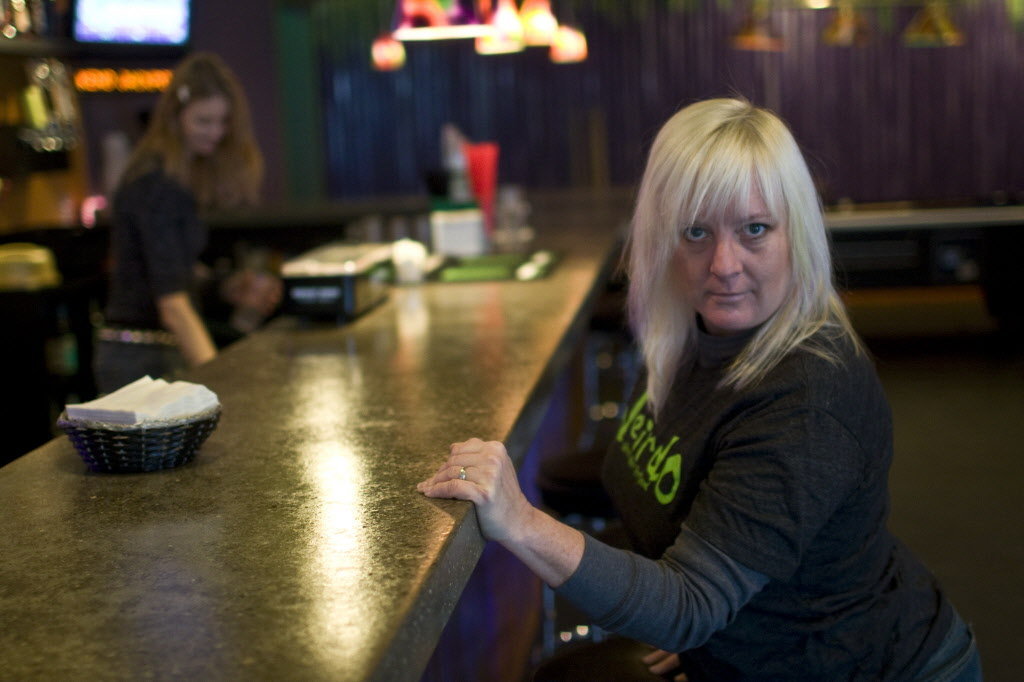
In the Fall of 2009 rumors began that the E Room would close. For months every event there was the “final” or “last” one. People pleaded with them to accept help in the form of a “Save the E Room” fundraiser. So when the news finally became official and it turned out that they were simply rebranding as The Weird Bar it came as an even bigger blow. The premise that this new venue was for anyone that considered themselves a little “weird” but was “normal-friendly” felt uncomfortable at best and, in a way, a “weird” take on the notion of reclaiming the word queer. They at once insulted their own community while simultaneously alienating them in the name of “inclusivity.” Further explanation of the process did little to help the situation. In a press release Davis explained:
When we first announced the closing we weren’t sure what direction we were headed, we just knew we could not keep doing what we are doing. We were meeting with a developer, and were also involved in conversations with private parties and a business broker. We were weighing all of our options. If our economy was in better shape we wouldn’t have had to make these tough decisions. It seems that so many of our customers are laid off, or have very little work, and this has been very evident over the last couple of years. Please know that we did not come to this decision lightly.
After much deliberation, we came up with a concept which is not completely complete yet. But, we made the decision to go with an all-inclusive venue (not to be confused with a straight venue). But…what to call it? This bar has such a weird layout. It’s such a weird bar. Hey! That’s the name! Weird Bar! We could have some weird drinks, weird promotions…all sorts of weird stuff and nothing would ever have to make sense again! We believe that all people are “weird” in one way or another…our uniqueness is what makes us special…makes us human. So, we would like to invite you to the grand opening of “Weird Bar”, on October 16. Weird Bar will be an all-inclusive space where anyone can be themselves, whatever form of “queerness” that may entail.
Celebrating differences. Enjoying common ground.
Aside from feeling somewhat disingenuous, it was also one of the most poorly written pieces of PR I had ever read, and went to the heart of their inability to successfully strategize as a business or grow with the community. Local fellow queer business owner and activist Stacy Bias responded with this heartfelt message:
I feel “weird” about the only lesbian bar closing and opening up again with the same ownership as straight bar. I get that it’s a niche market that you felt couldn’t sustain you, but there were other options that would have allowed you to be as loyal to your clientele as they have been to you over the years. Regardless, if you knew that you were opening up a new bar in the same space — a new bar that your loyal clientele would feel less at home in, that should have been transparent from the start. It’s like taking an ice cream cone away from your daughter and giving it to your son — when he’s already holding an ice cream cone in his other hand. Straight folks have every other bar in Portland. When the e-room closes, dykes have no focused space left at all.
…they’re throwing the dykes under the bus by not openly declaring their loyalty any longer to the queer community and catering to the so-called “normal” crowd (with, ironically, a bar called “weird.”) Having a conversation with the community about it, saying they’re struggling and need to open it up, being open about the process and giving folks a chance to have their feelings about it would have been a much better choice. It’s a business, yes, but by virtue of being a community gathering place for as long as it has, it isn’t just a business because of the emotional impact it has on the people who have had a safe place to go for so long and might not have it any longer…
We all hated the E Room but, as bad as it was, we were sad to see it go because it was all we had. Once it began operating as the Weird Bar there was really nothing left for us there. All the things we hated — uninviting space, watery drinks — were still there, while the only reason to go, that is was a dedicated dyke bar, was gone. In less than a year, the Weird Bar was closed for good.

Now, arguably, it is not all we have. On any given day my tired post-30 year old self can turn down numerous invites to this queer party, that gay rock show, a lesbian sing-a-long or a transmasculine artist’s opening show. But there is no lesbian bar. Sure, there’s the Florida Room, North Portland’s de facto dyke hangout that we all pretend to make fun of but run into each other at every week nonetheless. It’s welcoming enough to a diverse queer and genderqueer crowd, along with the rest of hipster PDX. But it is not queer owned and it is not named as a queer space on any level.
Is that important? Perhaps not. When I ask that question of the youngest queers often the immediate response I get is no. They feel accepted in this town and are happy to frequent any bar with a good happy hour menu because they are likely not to be the only queers there.
“Not having a named space helps keep things fresh,” says one such young queer woman, Sarah Hardy. “My dad and [his trans friend] were in town recently and went to Embers [a longstanding gay bar complete with rainbow facade] and it was terrible.” They were unimpressed with the creepy and distinctly non-trans-friendly 80s/90s vibe.
This is an atmosphere and aesthetic that the E Room ascribed to. If they had been better designers, hired younger consultants, could it have become a place where the next generation wanted to hang out? If, instead of rebranding as being more inclusive to a “straight community,” could they have rebranded to reach a wider queer audience, thereby becoming a part of the rapidly changing Southeast Division corridor instead of falling victim to it?
Gentrification aside, this is another reason younger queers seem unenthusiastic about protecting lesbian bars. A transmasculine community member points out that naming a space is necessarily exclusionary and that, for a community invested in intersectionality and multi-faceted identities, this seems counterproductive.
And yet, others do feel like marginalized communities deserve named spaces, even as that definition does and must expand. These queers, often in their late 20s and 30s, do readily admit to a sadness at the death of the lesbian bar… at least without a more open queer bar replacement. And there is an argument to be made that marginalized communities still need named spaces. As much as lesbian bars should, and have, opened their doors to trans clientele and those throughout the gender spectrum, sexism and cissexism are still very much a part of the LGBT community as a whole. Can making a named space for the feminine and/or for women be a stance against such sexism? Local party promoter, DJ and commentator Katey Pants points out that, “…authenticity and desirability is placed in what is masculine in all communities. Thus, things that are not masculine of center and/or fag spaces are seen as stupid, joke worthy, uncouth, silly, jokes, pathetic, etc.” She goes on to say that few people ID as dykes/lesbians anymore, and though she has mixed feelings about those words herself, she is clearly concerned about femme silencing.
Any replacement for a dying breed of bar would look very different. If you’re not willing to grow with the community, accept and cater to trans people, people of color and have a staff that reflects the patrons, you are doomed to die off. But though so many have talked about their visions for a new queer bartopia no one has yet been able to make it a reality. Is this due to lack of business savvy, lack of capital or just plain old Portland apathy? It’s hard to say. One friend even suggested that the owners of the Lexington open up shop here seeing as the real estate is so much cheaper and isn’t every other Californian buying up Oregon real estate anyway? It might as well be us (if we define us as LGBT and not as Oregonians that is).
What about those California, east coast, southern, midwestern and other transplants anyway? As a Portland native, it’s easy for me to feel plugged in to all the queer events taking place. But since the demise of local queer publications (almost in tandem with our bars) it can be hard to keep track of these rotating spaces if you’re less familiar with the party promoters, DJs, event planners etc. And if you’re from out of town, forget about it; no queer parties appear in that Lonely Planet, hip and up-to-date as it may be for a travel guide.
Interestingly, this conversation took place at an event called “Temporary Lesbian Bar” which is the closest thing I’ve seen to a successful recent named queer women’s space in PDX. Started by musician Katy Davidson, TLB is a fairly intimate affair with board games, pizza and conversation as well as a tiny dance floor. “Though the event is clearly not limited to lesbians alone, it feels powerful to set aside a space to encourage women to commune. I purposely keep the volume of the music at a level in which it is loud enough to dance, but also quiet enough to converse,” she says before going on to talk about using to term “lesbian” both ironically and as a tip of the hat to our elders. For even more real irony, actually quite sad, she expounds on women’s spaces saying, “I’m inspired by the longevity of the Lexington Club in San Francisco, for example. Purely from a personal standpoint… Let’s face it, we live in a world now where lines are becoming more and more blurred. In spite of this, women are still oppressed in our country, even in the most seemingly innocuous of ways. Women should have a space! It doesn’t have to be exclusive, but I believe women should be encouraged to interact together in meaningful ways.”
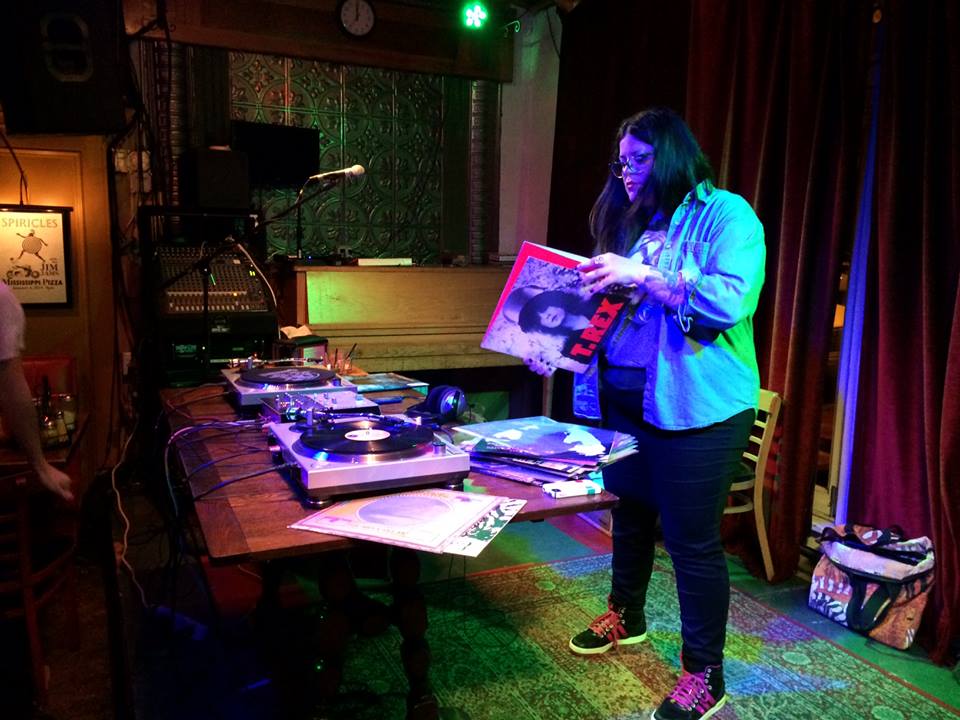
TLB has fulfilled this need in a very successful way that feels more like a neighborhood bar than other events, and I understand the sentiment that perhaps an everyday establishment is unsustainable even if I, personally, wish I had a place to go whenever I want rather than having to wait for a very specific 4 hour window once a month on Saturday evening. Certainly, it seems, anecdotally, that queers in Portland spend enough money on food and drink that we could hold together a bar/cafe/restaurant if we really rallied behind it. But maybe it owes more to an increasing cultural inability to concentrate, a kind of collective attention deficit, that the lesbian bar can only survive in popup form. Even lesbians in their 40s such as Caryn Brooks seem to think the move is a good one. “I think it’s actually more vibrant now than it was when there was a lesbian bar,” she notes. “It’s nimble, able to respond to geography and demographics. There’s no going back.”
But nimble also implies a level of instability, inconstancy to me, a comfort that I might miss, even as I sit here with 20 Chrome tabs open and the television on. And then there’s the anxiety that comes from not being able to keep up, unsure if you saw the right Facebook invite and needing to go to every event just so you won’t have FOMO (Fear of Missing Out) if you can’t get out at the exact time everyone else is.
Even if you are in the know and ready to party, you might not want to wait until 10pm on a Saturday to feel like you are among your people. Taylor Hatmaker, former Autostraddle Tech Editor, doesn’t like that everything has shifted to a “get fucked up one night a week at this special party” model and would welcome a place where you can get a drink or a cup of tea at any time. A bar may revolve around alcohol to some extent, but not every dive is necessarily a major event (which most besides TLB seem to bill themselves as) where there is added social pressure and a concentrated air of consumption that is distinctly not your local queer Cheers. Also, that place where everybody knows your name is more likely to be queer owned than a normally straight club whose goal is to be make money off of drunk queers jumping toward frenzied bartenders in search of their third double over giving back to the community by hosting a youth resource center fundraising drag show. As terrible as the decor may have been, these were things the E Room did.
Here’s where I’m going to let myself get a little nostalgic, at least the kind of nostalgia that comes from things you weren’t there for, like how I always complain that I’m sad I missed the 70s because they sounded, like, so rad (according to my aunt, my mother and the Lesbian Herstory Archives). Because we, as individuals, may not have a particular connection to a particular lesbian bar that has gone under doesn’t mean that the death of the lesbian bar, in general, isn’t a tragedy. Clearly, I had my own issues with the E Room. I thought it was dirty; I thought the bartenders were mean; I was appalled by the website and the corresponding paint job. Straddlers have had similar thoughts about the Lex. But there is a whole history of the lesbian bar that we have already missed and, in writing this article, I have discovered some of that, and with it a whole new sadness.
The LGBT history of Portland, Oregon is rich and surprisingly old for such a “young” city. A 1999 documentation of a Gay Portland Walking Tour introduces us to the vast number of bars that catered to the gay and lesbian population throughout the 20th Century. Clearly bars have helped build community. Highlights include The Milwaukee Tavern (1535 W Burnside though address since renumbered) which was “fingered” in the 1964 vice reports of Chief of Police McNamara as being a lesbian hangout:
The reports noted that it was frequented almost entirely by women who “dress like men, act like men, and are believed to be from areas outside Portland.” Owner Edna Jordal was a widow at the time of the Portland City Council hearings in December 1964. She had worked previously at the Transfusion Inn, a notorious lesbian dive located on Southwest Front almost at water level. The only employees at the Milwaukee Tavern were women. One, the manager, was identified in the records as “Miss Lewis” who had “served eight years in the service with an honorable discharge,” and the other a young woman of 22 who moonlighted in the evenings following her day job at Meier & Frank.
Then there was the The Buick Café (1239 SW Washington) a little place to grab some nosh downtown that late 40s/early 50s Police Department’s Women’s Protective Division claimed by frequented by lesbians who took up space at the Music Hall, a nightclub on 10th and Stark. A precinct report stated that this group tried to pick up ladies at the club and, upon failure, moved to the cafe (not a bad tactic if you ask me) adding, “these women were recently ousted from San Francisco for their actions and are, apparently, confirmed lesbians.” So even then the California exodus to Oregon was a thing.
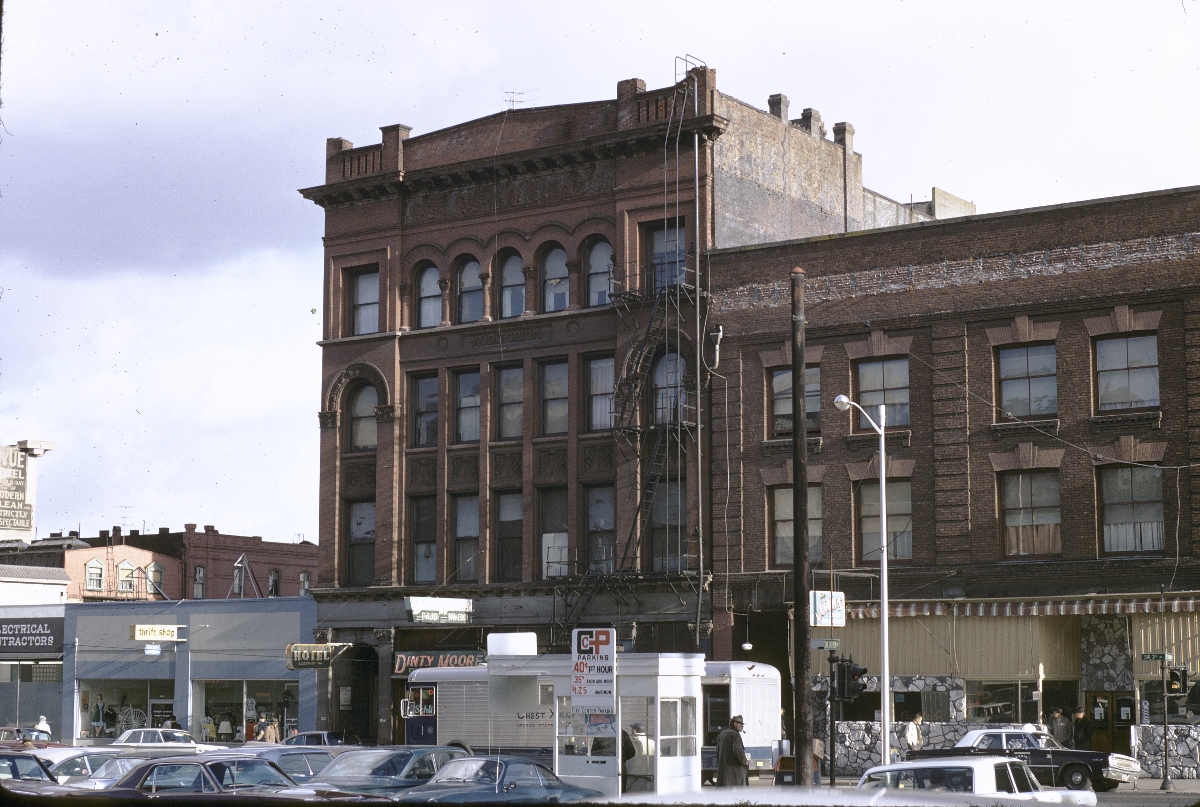
In an amazing web/mobile app local history project called the PDX Social History Guide I discovered a treatise on lesbian spaces by Portland State University Professor Ann Mussey. Aside from her stories about collective living experiments, which hopefully I’ll get to in another article some day because I once thought I’d do a PhD on the subject, she also discusses early lesbian bars such as Magic Gardens and Dinty Moore’s.
They were important to her because there weren’t other public places where women could dance, hold hands, flirt, but even then she says it wasn’t the only thing happening. There were their own quasi-public collectives and get-togethers. Women have always wanted more than bars. But we still want bars. And the way Murray describes the Dinty Moore dive, with it’s wood paneled walls and piles of liquor bottles reflected in the giant mirror, is a place I wish I could have seen. And though she readily admits that some might have, rightly, called her a “class tourist,” her community was also necessarily invested in creating mixed class spaces.
Then there was Magic Gardens, which was owned by a woman and tended by gay twins. Even then, these spaces didn’t last. Magic Gardens turned into a strip club, and though it was not, as it was to Mussey’s naïve young mind, a strip club specifically for women, it has maintained itself as one of the most female-friendly, worker-managed strip clubs in our erotic dance fueled city. Now even this form of the business is going under, as it is set to close at the end of this year.
Mussey also talks of the Rising Moon, which was owned by lesbians, and which had issues with racial tension and a leafleting campaign by lesbians of color who believed they had been unfairly targeted in carding. She speaks of the Tasha’s, The Ramp, 316 and others which were all short-lived and imperfect. So there has never been just the right place for all queer women to sing Kum-Ba-Yah together, but we have continued to desire a place to be, have worked toward a space to be together even in our differences. So what happens when these places, as problematic as they may have been, disappear altogether?
In some ways, nothing. We continue to have places to gather in both physical and virtual spaces and, goddess knows, we never have a lack of things to say. Conversations around queer women’s topics, which are vast and contain multitudes, happen everywhere all the time. But one of these should, perhaps, be a mourning of our loss of lesbian space, the lesbian bar, and what that means. Certainly we should be documenting it, and projects like the the Unknown Play Project are doing just that. Even as we struggle to move forward with new understandings of queer women and how we want to congregate and collect there is a powerful history that can feel missing. This juxtaposition of past and future has been felt in a lot of ways recently; I am thinking here of our recent roundtable on the passing of Leslie Feinberg, whose stories sited the bar as a place of beginning, understanding, butch/lesbian/trans/genderqueer life. We can grieve for what it stood for while simultaneously moving on.
As long as we keep making our own spaces.





